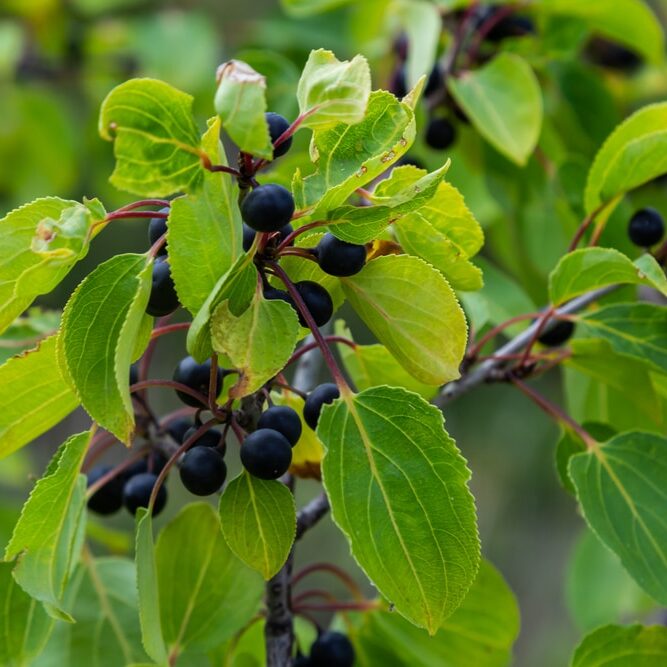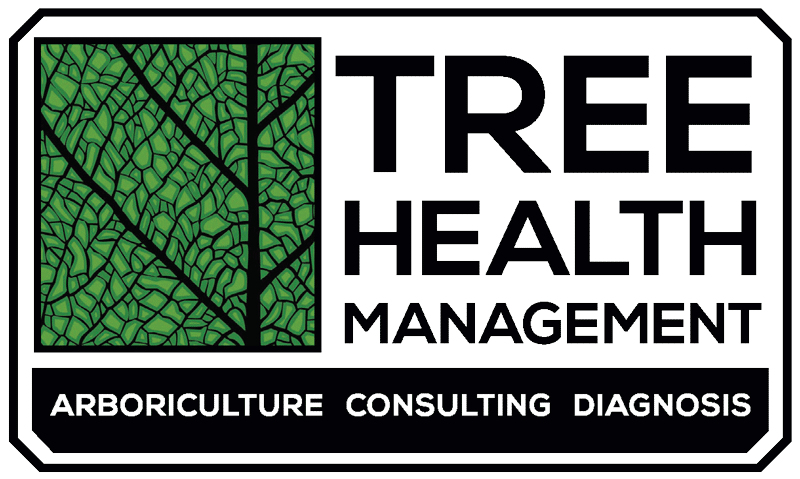Blog
Buckthorn Removal

Rhamnus cathartica
Known as Common Buckthorn, European Buckthorn, or Carolina Buckthorn, Buckthorn is native to Europe and western Asia and was introduced to the Midwest as hedging material. It spread quickly into the natural environments shortly after. Here in Wisconsin, it has invaded Oak forests, prairies, riparian forests, wetlands, and roadsides. The Wisconsin Department of Natural Resources lists it on the NR-40 as “restricted,” meaning it has the potential to cause significant environmental or economic harm, or is harmful to human health. It is already established in Wisconsin environments, and we all have a collective duty to reduce its presence when we can.
Common Buckthorn has a few distinct features. The leaves are dark glossy green with dentate (toothy) edges, and a narrow tip. Its leaves remain green long into Fall, and some yellow leaves tend to hang onto branches through the Winter. The tip of each twig ends in a short, sharp thorn. The bark is shiny grey with prominent lenticels. If you cut the branch, the sapwood is yellow, and the heartwood appears bright orange. Green fruits turn deep purple, almost black in Fall, later than native Chokecherry. Buckthorn shrubs can grow to 20 feet tall, are usually multi-stemmed, and grow dense thickets.
There are a number of reasons why it’s considered so harmful to the environment. First, it grows and spreads quickly and aggressively. It has a fast growth rate, often out-competing native plants for light, space, and water. It doesn’t take long for Buckthorn to become the dominant species in an environment. Female Buckthorn shrubs produce huge numbers of berries each year, each containing 3-4 seeds. Birds love to eat the berries, but can’t digest the seeds, depositing them far and wide. The seeds can remain dormant in the soil for several years and produce new plants years later. This means that a bird can eat berries from a single bush in your yard and cause shrubs to emerge in the forest down the road in the future. Second, Buckthorn can eliminate understory plants and degrade the environment. It forms large, dense, thorny thickets that are impossible for wildlife (and people) to penetrate. Since buckthorn leafs out early in the Spring, and hangs onto green leaves late into the Fall, it effectively shades out our native understory plants. Without understory plants, the soil beneath Buckthorn thickets erodes away faster in rain storms and snow melt. The lack of food sources from native plants reduces wildlife diversity. Lastly, Buckthorn can also be harmful to people and the economy. It is a host plant to crown nest fungus, alfalfa mosaic fungus, and soybean aphids, which are harmful to nearby croplands,. Buckthorn berries are poisonous, but can be mistaken for native Chokecherry, which is edible. Make sure to never eat a plant you aren’t sure of and keep an eye on children when outside.
If you have Buckthorn on your property, there are a few options for removal. Mechanical removal involves digging up and disposing of buckthorn shrubs. If taking this route, focus on removing the fruit-bearing female shrubs first to stop the productions of new seeds. Be aware that new sprouts can emerge from roots left behind. Chemical control includes cutting the stems down to a stump and using systemic herbicides to kill the roots. Consult a professional for herbicide use. Depending on your site and local regulations, controlled burns can be used to control Buckthorn. Be aware of fire-sensitive native plants in the area. Grazing goats have also shown to be effective at controlling Buckthorn. More successful control efforts involve combining multiple of the above methods. No matter what, getting Buckthorn under control will be a multi-year effort to control sprouts that re-emerge over time. Talk to your arborist about control methods, or consult the Wisconsin DNR at dnr.wisconsin.gov.
Once Buckthorn is under control, consider replacing it with native understory shrubs. Many can also be used as screening or hedging material. Native substitutes for hedging material include the following:
- Highbush Cranberrry, Viburnum trilobum
- Nannyberry, Viburnum lentago
- Chokecherry,Prunus virginiana
- Grey Dogwood, Cornus racemosa
- American Hazelnut, Corylus americana
- American Hornbeam, Carpinus caroliniana
- Black Chokecherry, Aronia melanocarpa
- Juneberry, Amelanchier
